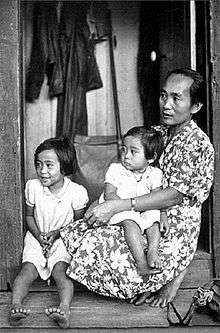Filipinos in Hawaii
People of Filipino descent make up a large and growing part of the State of Hawaii's population. In 2000 they were the third largest ethnic group and represented 22.8% of the population,[2] but more recent data indicates they have become the largest ethnicity in Hawaii (25.1% in 2010).
Filipinos and Hawaiian languages are distantly related to each other, being in the Malayo-Polynesian group of Austronesian languages and peoples.
History

Filipino immigrants, c. 1906
Early 20th Century
The importation of Filipino workers for the sugarcane plantations began between 1906 and 1910. By the 1920s Filipinos in Hawaii were still largely male, men outnumbered women by nearly seven to one, and unmarried. They represented, at one point, half of the workers in the sugar industry. Initially the Filipinos tended to be "peasants" of lower education than other groups.[3]
After 1965
The Immigration and Nationality Act of 1965 allowed more Filipinos to bring family to Hawaii and this allowed more Filipino arrivals, particularly Filipino women, to enter the state. The increase in arrivals also caused some backlash and in the 1970s Filipinos felt discriminated against. They also tended to do more poorly at schools than average in that decade.[4] In 1970, of the 93,915 Filipinos living in Hawaii, only 34.4% were high school graduates.[5]
Ethnic plurality
The 2010 census showed that Filipinos surpassed Japanese as Hawaii’s largest ethnic group. The total population of Filipinos was 342,095 of which 197,497 were full Filipinos, the total population of Japanese was 312,292 of which 185,502 were full Japanese.[6][7] According to surveys conducted by the American Community Survey showed that Filipinos overtook Japanese between 2007 and 2008.[8]
References
- ↑ Magdelena, Federico V.; Aquino, Belinda A. (2010). "A Brief History of Filipinos in Hawaii". Center for Philippine Studies. University of Hawaii Manoa. Retrieved 18 February 2015.
"The Non-English Speaking Population in Hawaii" (PDF). Hawaii Economic Issues. State of Hawaii. 2011. Retrieved 18 February 2015. - ↑ Ethnicity and inequality in Hawaiʻi by Jonathan Y. Okamura
- ↑ The Filipino piecemeal sugar strike of 1924-1925, Volume 3 by John E. Reinecke, pgs 1-2
- ↑ People and cultures of Hawaii: a psychocultural profile by John F. McDermott, Wên-Shing Tsêng, Thomas Maretzki, pg 171-181
- ↑ Shepard, George (July 1974). "Population Profiles, Vol. 5: Demographic and Socioeconomic Profiles of the American Indian, Black, Chinese, Filipino, Japanese, Spanish Heritage, and White Populations of Washington State in 1970." (PDF). Education Resources Information Center. Washington Office of the State Superintendent of
Public Instruction, Olympia. Retrieved 31 October 2014.
- ↑ Jennifer Sinco Kelleher (21 May 2011). "Census shows Hispanics grow presence in Hawaii". The Maui News. Retrieved 30 December 2011.
- ↑ Ben Gutierrez (17 June 2011). "Filipinos now second-largest racial group in Hawaii". Hawaii News Now. Retrieved 30 December 2011.
- ↑ Filipinos Overtake Japanese As Top Hawaii Group by Michael Levine
Further reading
- Labrador, Roderick N. Building Filipino Hawai'i (University of Illinois Press; 2015) 170 pages
|
|---|
| | Africa | |
|---|
| | Americas | |
|---|
| | Asia | |
|---|
| | Europe | |
|---|
| | Oceania |
- Hawaiian
- Marshallese
- Samoan
- Tahitian
- Tongan
|
|---|
|
|
|---|
| | Africa | | |
|---|
| | Americas | |
|---|
| | Asia | East Asia | |
|---|
| South Asia | |
|---|
| Southeast Asia | |
|---|
| West Asia | |
|---|
|
|---|
| | Europe | |
|---|
| | Oceania | |
|---|
|


